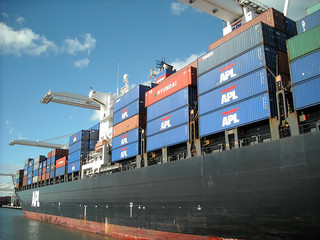 Beginning January 1, 2013, intermodal freight shippers in the Asia-U.S. container trade will begin paying a single, consolidated bunker surcharge that incorporates components for both low-sulfur fuel burned within 200-mile coastal limits, and long-haul intermodal fuel costs passed through by inland transportation providers.
Beginning January 1, 2013, intermodal freight shippers in the Asia-U.S. container trade will begin paying a single, consolidated bunker surcharge that incorporates components for both low-sulfur fuel burned within 200-mile coastal limits, and long-haul intermodal fuel costs passed through by inland transportation providers.
Member shipping lines in the Transpacific Stabilization Agreement (TSA) say the shift to a consolidated charge will dramatically simplify how inland intermodal fuel surcharges are assessed and collected, and provide customers with greater clarity in forecasting their total freight costs.
At present, TSA carriers assess a three-tiered intermodal fuel surcharge (IFS) that is based on U.S. Department of Energy weekly on-highway diesel fuel prices and the BNSF Railway formula for fuel surcharges paid under intermodal contracts with ocean carriers. Shippers pay either 1) a ‘West Coast/Group 4’ charge for short-haul inland moves in harbor areas and throughout western coastal states; 2) an East and Gulf Coast ‘Reverse Inland Point Intermodal’ (RIPI) charge for short-haul inland moves throughout the eastern and southeastern U.S.; or 3) a long-haul inland point intermodal charge, recovering long-haul rail fuel surcharges via the West Coast.
Effective January 1, the Group 4 and RIPI tiers for the IFS will be dropped, and the single, long-haul intermodal IFS tier will become an ‘Intermodal Component’ to the TSA guideline bunker charge. This component will be calculated in the same way it has been since the IFS was introduced in 2005, converting the BNSF formula – expressed as a percentage of the total intermodal rail charge – into a per-FEU charge that is then added to the basic marine bunker fuel charge. The Intermodal Component will only be applied to long-haul inland point and minilandbridge shipments from Asia moving via the West Coast.
As a result, TSA’s bunker charge going forward will be expressed in three parts: West Coast/Group 4; East Coast & Gulf/RIPI; and West Coast intermodal. For the calendar quarter beginning January 1, the West Coast Intermodal bunker charge will be $933 per 40-foot container, including a $538 marine bunker charge, a $15 low-sulfur component and a $380 intermodal component.
“Rather than have multiple, confusing charges that are negotiated separately, carriers felt it would be in the best interests of the trade as a whole to develop and assess a single, simplified charge that focuses on the area of greatest cost impact – long-haul intermodal rail fuel charges,” explained TSA executive director Brian M. Conrad. “The formula is unchanged and transparent, the costs are clear and verifiable, and carriers will no longer be chasing short-haul charges that often contribute only marginally to overall fuel cost recovery. As we see it, everyone benefits.”
Fuel-related charges for the calendar quarter beginning January 1 will be posted on the TSA website in the last week of November, to provide the trade with at least 30 days’ advance notice of any quarterly adjustment. At that time, the new bunker charge will be posted under “Current Charges” and will include both the low-sulfur and intermodal components incorporated into a single charge. In addition, TSA will continue to track 13-week inland fuel prices separately on the same “Surcharge Calculator” page as always, so that customers can calculate the contribution made by the Intermodal Component to the total bunker charge.
TSA is a research and discussion forum of major container shipping lines serving the trade from Asia to ports and inland points in the U.S.
Photo: jdnx




